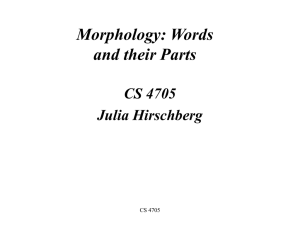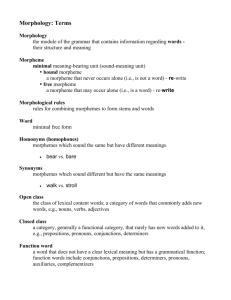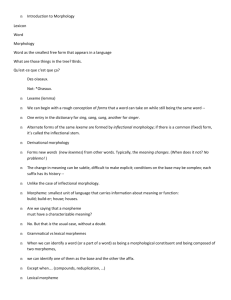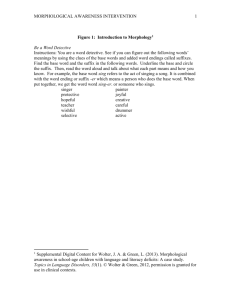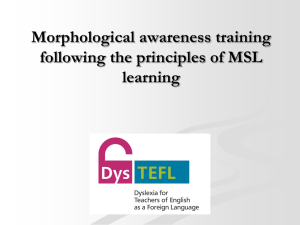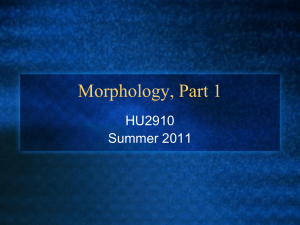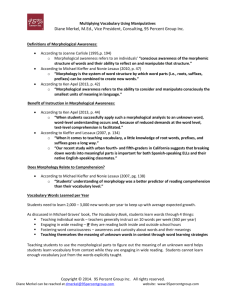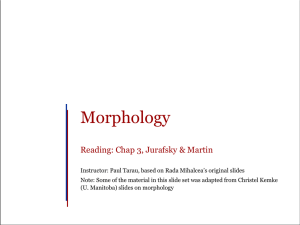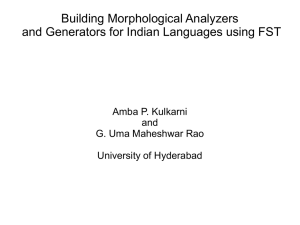Words and Their Parts
advertisement
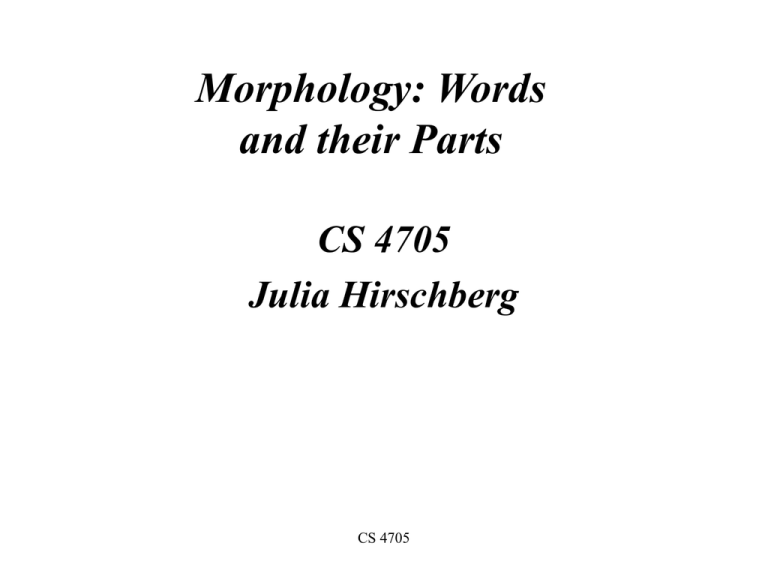
Morphology: Words and their Parts CS 4705 Julia Hirschberg CS 4705 Words • In formal languages, words are arbitrary strings • In natural languages, words are made up of meaningful subunits called morphemes – Morphemes are abstract concepts denoting entities or relationships – Morphemes may be • Stems: the main morpheme of the word • Affixes: convey the word’s role, number, gender, etc. • cats == cat [stem] + s [suffix] • undo == un [prefix] + do [stem] Why do we need to do Morphological Analysis? • The study of how words are composed from smaller, meaning-bearing units (morphemes) • Applications: – Spelling correction: referece – Hyphenation algorithms: refer-ence – Part-of-speech analysis: googler [N], googling [V] – Text-to-speech: grapheme-to-phoneme conversion • hothouse (/T/ or /D/) – Let’s us guess the meaning of unknown words • ‘Twas brillig and the slithy toves… • Muggles moogled migwiches Morphotactics • What are the ‘rules’ for constructing a word in a given language? – Pseudo-intellectual vs. *intellectual-pseudo – Rational-ize vs *ize-rational – Cretin-ous vs. *cretin-ly vs. *cretin-acious • Possible ‘rules’ – Suffixes are suffixes and prefixes are prefixes – Certain affixes attach to certain types of stems (nouns, verbs, etc.) – Certain stems can/cannot take certain affixes • Semantics: In English, un- cannot attach to adjectives that already have a negative connotation: – Unhappy vs. *unsad – Unhealthy vs. *unsick – Unclean vs. *undirty • Phonology: In English, -er cannot attach to words of more than two syllables – great, greater – Happy, happier – Competent, *competenter – Elegant, *eleganter – Unruly, ?unrulier Regular and Irregular Morphology • Regular – Walk, walks, walking, walked, (had) walked – Table, tables • Irregular – Eat, eats, eating, ate, (had) eaten – Catch, catches, catching, caught, (had) caught – Cut, cuts, cutting, cut, (had) cut – Goose, geese Morphological Parsing • Algorithms developed to use regularities -- and known irregularities -- to parse words into their morphemes • Cats cat +N +PL • Cat cat +N +SG • Cities city +N +PL • Merging merge +V +Presentparticiple • Caught catch +V +past-participle Morphology and Finite State Automata • We can use the machinery provided by FSAs to capture facts about morphology • Accept strings that are in the language • Reject strings that are not • Do this in a way that does not require us to list all the words in the language How do we build a Morphological Analyzer? • Lexicon: list of stems and affixes (w/ corresponding part of speech (p.o.s.)) • Morphotactics of the language: model of how and which morphemes can be affixed to a stem • Orthographic rules: spelling modifications that may occur when affixation occurs – in il in context of l (in- + legal) • Most morphological phenomena can be described with regular expressions – so finite state techniques often used to represent morphological processes Some Simple Rules • Regular singular nouns stay as is • Regular plural nouns have an -s on the end • Irregulars stay as is Simple English NP FSA Expand the Arcs with Stems and Affixes dog cat geese child • We can now run strings through these machines to recognize strings in the language • Accept words that are ok • Reject words that are not • But is this enough? • We often want to know the structure of a word (understanding/parsing) • Or we may have a stem and want to produce a surface form (production/generation) • Example • From “cats” to “cat +N +PL” • From “cat + N + PL” to “cats” Finite State Transducers (FSTs) • Turning an FSA into an FST • Add another tape • Add extra symbols to the transitions • On one tape we read “cats” -- on the other we write “cat +N +PL” • Or vice versa… Koskenniemi 2-level Morphology Kimmo Koskenniemi’s two-level morphology Idea: a word is a relationship between lexical level (its morphemes) and surface level (its orthography) c:c a:a t:t +N:ε +PL:s • c:c means read a c on one tape and write a c on the other • +N:ε means read a +N symbol on one tape and write nothing on the other • +PL:s means read +PL and write an s Not So Simple • Of course, its not all as easy as • “cat +N +PL” <-> “cats” • What do we do about geese, mice, oxen? • Many spelling/pronunciation changes go along with inflectional changes, e.g. • Fox and Foxes Multi-Tape Machines • Solution for complex changes: – Add more tapes – Use output of one tape machine as input to the next • To handle irregular spelling changes, add intermediate tapes with intermediate symbols Example of a Multi-Tape Machine • We use one machine to transduce between the lexical and the intermediate level, and another to transduce between the intermediate and the surface tapes FST Fragment: Lexical to Intermediate • ^ is morpheme boundary; # is word boundary FST Fragment: Intermediate to Surface • Rule: insert an e after a morpheme-final x, s or z and before morpheme s, eg. fox^s# foxes Putting Them Together Practical Uses • This kind of parsing is normally called morphological analysis • Can be • An important stand-alone component of an application (spelling correction, information retrieval, part-of-speech tagging,…) • Or simply a link in a chain of processing (machine translation, parsing,…) Porter Stemmer (1980) • Standard, very popular and usable stemmer (IR, IE) – identify a word’s stem • Sequence of cascaded rewrite rules, e.g. – IZE ε (e.g. unionize union) – CY T (e.g. frequency frequent) – ING ε , if stem contains vowel (motoring motor) • Can be implemented as a lexicon-free FST (many implementations available on the web) Important Note: Morphology Differs by Language • Languages differ in how they encode morphological information – Isolating languages (e.g. Cantonese) have no affixes: each word usually has 1 morpheme – Agglutinative languages (e.g. Finnish, Turkish) are composed of prefixes and suffixes added to a stem (like beads on a string) – each feature realized by a single affix, e.g. Finnish epäjärjestelmällistyttämättömyydellänsäkäänköhän ‘Wonder if he can also ... with his capability of not causing things to be unsystematic’ – Polysynthetic languages (e.g. Inuit languages) express much of their syntax in their morphology, incorporating a verb’s arguments into the verb, e.g. Western Greenlandic Aliikusersuillammassuaanerartassagaluarpaalli. aliiku-sersu-i-llammas-sua-a-nerar-ta-ssa-galuar-paal-li entertainment-provide-SEMITRANS-one.good.at-COPsay.that-REP-FUT-sure.but-3.PL.SUBJ/3SG.OBJ-but 'However, they will say that he is a great entertainer, but ...' – So….different languages may require very different morphological analyzers Concatenative vs. Non-concatenative Morphology • Semitic root-and-pattern morphology – Root (2-4 consonants) conveys basic semantics (e.g. Arabic /ktb/) – Vowel pattern conveys voice and aspect – Derivational template (binyan) identifies word class Template CVCVC CVCCVC CVVCVC tVCVVCVC nCVVCVC CtVCVC stVCCVC Vowel Pattern active katab kattab ka:tab taka:tab nka:tab ktatab staktab passive kutib write kuttib cause to write ku:tib correspond tuku:tib write each other nku:tib subscribe ktutib write stuktib dictate Morphological Representations: Evidence from Human Performance • Hypotheses: – Full listing hypothesis: words listed – Minimum redundancy hypothesis: morphemes listed • Experimental evidence: – Priming experiments (Does seeing/hearing one word facilitate recognition of another?) suggest something in between • Regularly inflected forms (e.g. cars) prime stem (car) but not derived forms (e.g. management, manage) • But spoken derived words can prime stems if they are semantically close (e.g. government/govern but not department/depart) • Speech errors suggest affixes must be represented separately in the mental lexicon – ‘easy enoughly’ for ‘easily enough’ • Importance of morphological family size – Larger families faster recognition Summing Up • Regular expressions and FSAs can represent subsets of natural language as well as regular languages – Both representations may be difficult for humans to understand for any real subset of a language – Can be hard to scale up: e.g., when many choices at any point (e.g. surnames) – But quick, powerful and easy to use for small problems – AT&T Finite State Toolkit does scale • Next class: – Read Ch 4 on Ngrams – HW1 will be due at midnight on Oct 1

